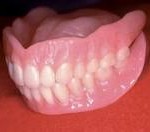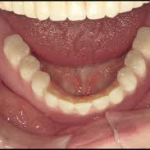Denture base extension:
a) The labial and buccal extension:
- If marked overextension of the flanges, will stretch the sulcus tissues when denture inserted, leading to elastic recoil result in dislodgment of the denture, immediate denture displacement after its seating.
Examination of the extension
 Insert of the upper trial denture in its place with light pressure on the occlusal surface, move the check in functional movement. Release of the pressure, the denture will falls down. Need adjustment till little or no movement occurs.
Insert of the upper trial denture in its place with light pressure on the occlusal surface, move the check in functional movement. Release of the pressure, the denture will falls down. Need adjustment till little or no movement occurs.
- Also under extension of the upper trial denture, leading to poor physical retention. Correction will usually entail making a new final impression.
- Provision of the frena {labial and buccal} should be done to ensure that they have adequate clearance and the denture should be thinned and blended in these areas.
b) Posterior extension:
The posterior border of the upper trial denture base should extended from the hamular notch to the other along the vibrating line of the soft palate, and correctly placed on the master cast. If the p.p.s is not done before. It should be done at this stage.
Retention:
It is noted that the retention of the trial denture is less than that of completed denture, due to:
- Absence of a posterior palatal seal.
- Poor adaptation of the trial denture base to the tissues.
- The trial denture should be stay in position when the mouth is opened. Looseness of the upper trial denture make it impossible to carry out an accurate assessment of the occlusion {may use denture fixative} especially, in patients with unfavorable anatomical factors.
How to test the retention of the upper denture?
- Seat the upper trial denture with a firm upward and backward pressure.
- Allow the tissues to settle around the denture
- Grip the labial and lingual surfaces of the upper denture teeth between the thumb and forefinger
- Apply a firm downward vertical pull to dislodge the denture away from the tissues, {if the retention is good, dislodgment of the trial denture may be difficult}
The shape of the polished surface on the buccal surface should take the form of a gentle concavity to aid denture retention.
Retention contributing factors are:
- Absence of a border seal resulting from under extension of the denture base.
- Inadequate width of the flange
- Ineffective seal at the posterior border
- A poor fit of the denture base.
Stability:
It is tested by applying pressure in a tissue ward direction with the ball of the index finger in the premolar and molar regions on each side alternately. This pressure must be directed at right angles to the occlusal surface where displacement does occur.
Causes of instability:
• Warpage of the denture base.
• Posterior teeth set buccal to the underlying alveolar ridge
• Hard unrelieved area in the midline e.g. torus palatinus.
Orientation of the occlusal plane:
Properly oriented occlusal plane is important to:
- Patient esthetics.
- Patient comfort
- Chewing function
- Balance of occlusion
Orientation of the anterior end of the occlusal plane is determined by esthetics.
- The amount of the upper anterior teeth that will be seen during speech and facial expression depends on length and movement of the upper lip. If the upper lip is relatively long, the natural teeth may not be visible when the lip is relaxed or even during speech. The reverse is true. The movement of the lips during function varies considerably among patient thus, when artificial teeth are placed in the same position as the natural teeth, the amount of the upper teeth that will be visible varies for each patient.
- The lower lip is better guide for the vertical orientation of the anterior teeth than the upper lip. In most patients, the incisal edges of the natural lower canines and the cusp tips of the lower first premolars are located at the level of the lower lip at the corner of the mouth when the mouth is slightly open. When the lower teeth are above the lip at the corner of the mouth so it may be due to one or a combination of the following conditions:
a) The plane of occlusion may be too high.
b) The vertical overlap of the anterior teeth may be excessive.
c) The vertical space between the jaws may be excessive. - The posterior end of the occlusal plane should be at the level of the anterior two thirds of the retro molar pad.
- The final check of the occlusal plane level is to determine whether the plane of occlusion is appropriate cosmetically for the patient in general
{At rest, during speaking, and smiling}.

